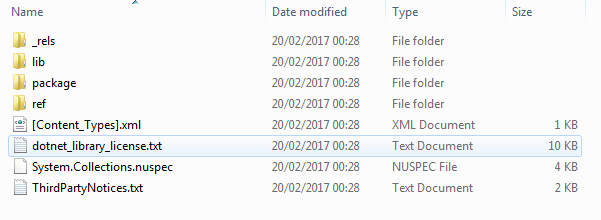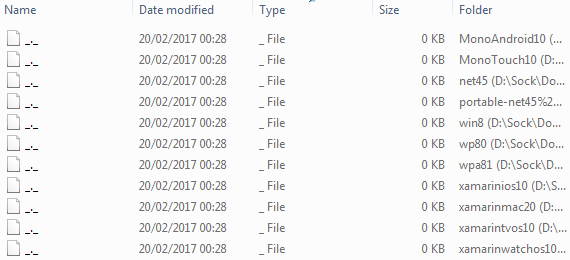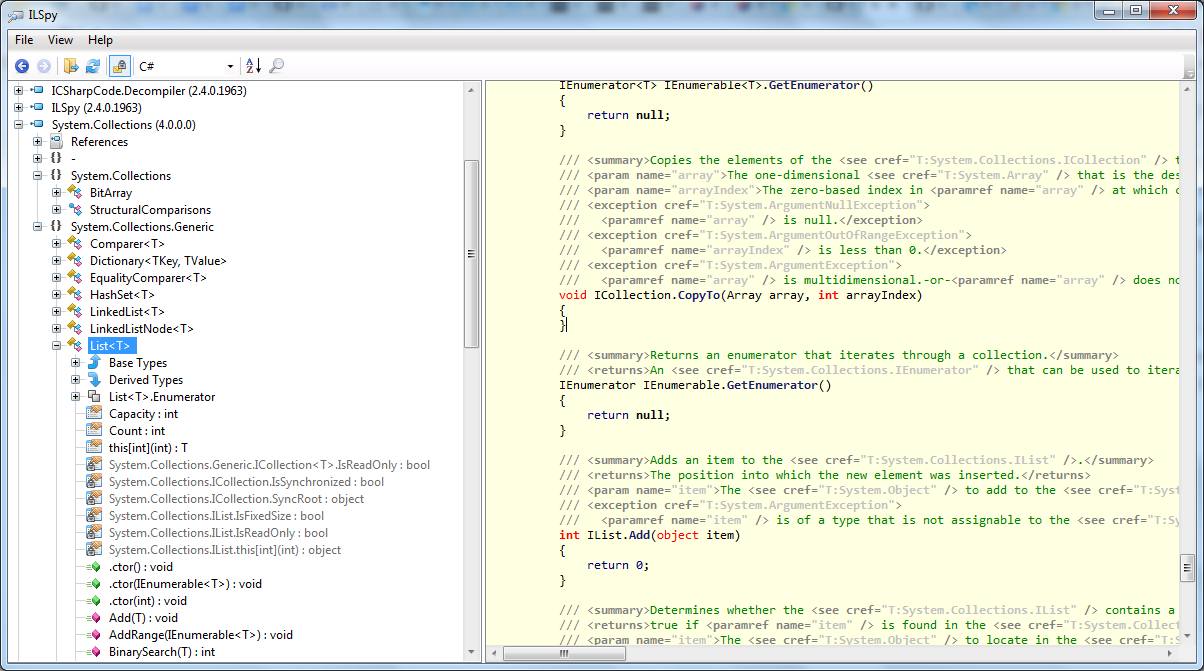What is the NETStandard.Library metapackage?
In my last post, I took a quick look at the Microsoft.AspNetCore meta package. One of the libraries referenced by the package, is the NETStandard.Library NuGet package. In this post I take a quick look at this package and what it contains.
If you're reading this post, you have hopefully already heard of .NET Standard. This is acts as an interface to .NET Platforms, and aims to define a unified set of APIs that those platforms must implement. It is the spiritual successor to PCLs, and allow you to target .NET Framework, .NET Core, and other .NET platforms with the same library code base.
The NETStandard.Library metapackage references a set of NuGet packages that define the .NET Standard library. Like the Microsoft.AspNetCore package from my last post, the package does not contain dlls itself, but rather references a number of other packages, hence the name metapackage. Depending on the target platform of your project, different packages will be added to the project, in line with the appropriate version of .NET Standard the platform implements.
For example, the .NET Standard 1.3 dependencies for the NETStandard.Library package includes the System.Security.Cryptography.X509Certificates package, but this does not appear in the 1.0, 1.1 or 1.2 target platforms. You can also see this on the nuget.org web page for the package.
It's worth noting that the NETStandard.Library package will typically be referenced by projects, though not by libraries. It's also worth noting that the version number of the package does not correspond to the version of .NET Standard, it is just the package version.
So even if your project is targeting .NET Standard version 1.3 (or multi-targeting), you can still use the latest NETStandard.Library package version (1.6.1 at the time of writing). The package itself is versioned primarily because it also contains various tooling support such as the list of .NET Standard versions.
It's also worth bearing in mind that the NETStandard.Library is essentially only an API definition, it does not contain the actual implementation itself - that comes from the underlying platform that implements the standard, such as the .NET Framework or .NET Core.
If you download one of the packages referenced in the NETStandard.Library package, System.Collectionsfor example, and open up the nuget package as before, you'll see there's a lot more too it than the Microsoft.AspNetCore metapackage. In particular, there's a lib folder and a ref folder:

In a typical NuGet package, lib is where the actual dlls for the package would live. However, if we do a search for all the files in the lib folder, you can see that there aren't actually any dlls, just a whole load of empty placeholder files called _._ :

So if there aren't any dlls in here, where are they? Taking a look through the ref folder you find a similar thing - mostly _._ placeholders. However that's not entirely the case. The netstandard1.0 and netstandard 1.3 folders do contain a dll (and a load of xml metadata files):

But look at the size of that System.Collections.dll - only 42kb! Remember, the NETStandard.Library only includes reference assemblies, not the actual implementations. The implementation comes from the final platform you target; for example .NET Framework 4.6.1, .NET Core or Mono etc. The reference dlls just define the various APIs that these platforms must expose for a given version of .NET Standard.
You can see this for yourself by decompiling the contained dll using something like ILSpy. If you do that, you can see what looks likes the source code for System.Collections, but without any method bodies, showing that this really is just a reference assembly:
These placeholder assemblies are are a key part of the the .NET Standard infrastructure. They provide concrete APIs against which you can compile your projects, without tying you to a specific implementation (i.e. .NET Framework or .NET Core).
Final thoughts
If this all seems confusing and convoluted, that's because it is! It doesn't that every time you think you've got your head around it, things have moved on, are being changed or improved…
Having said that, most of this is more detail than you'll need. Generally, it's enough to understand the broad concept of .NET Standard, and the fact that it allows you to share code between multiple platforms.
There's a whole host of bits I haven't gone into, such as type forwarding, so if you want to get further into the details, and really try to understand what's going on, I suggest checking out the links below. In particular, I highly recommend the video series by Immo Landwerth on the subject.
Of course, when .NET Standard 2.0 is out, all this will change again, so brace yourself!
- https://blogs.msdn.microsoft.com/dotnet/2016/09/26/introducing-net-standard/
- https://github.com/dotnet/standard/blob/master/docs/faq.md
- https://docs.microsoft.com/en-us/dotnet/articles/standard/library
- https://github.com/dotnet/standard/blob/master/docs/netstandard-20/packaging.md
- https://www.youtube.com/watch?v=YI4MurjfMn8&list=PLRAdsfhKI4OWx321A_pr-7HhRNk7wOLLY
from:https://andrewlock.net/what-is-the-netstandard-library-metapackage/
What is the NETStandard.Library metapackage?的更多相关文章
- 'Newtonsoft.Json' already has a dependency defined for 'NETStandard.Library'
安装NEST的时候报了如下的错误: PM> Install-Package NEST Attempting to resolve dependency 'Elasticsearch.Net (≥ ...
- .Net Core 中的包、元包与框架(Packages, Metapackages and Frameworks)
包,元包与框架 本文翻译自 Packages, Metapackages and Frameworks. .Net Core 是一种由 NuGet 包组成的平台.一些产品体验受益于代码包的细粒度定义, ...
- .NET Core中的包、元包与框架
本文为翻译文章,原文:Packages, Metapackages and Frameworks .NET Core是一个由NuGet包组成的平台.一些产品受益于细粒度包的定义,也有一些受益于粗粒度包 ...
- .Net Core 学习笔记1——包、元包、框架
.Net Core 是由NuGet包(package)组成的平台. 一起使用的多个包的集合:元包(Metapackage) package 包 (对应以前的程序集概念) Framework 框架 as ...
- .NET Core 系列5 :使用 Nuget打包类库
NuGet是个开源项目,项目包括 NuGet VS插件/NuGet Explorer/NuGetServer/NuGet命令行等项目,.NET Core项目完全使用Nuget 管理组件之间的依赖关系, ...
- .NET Core系列 :3 、使用多个项目
通过前面的两篇文章,我们已经知道如何创建新的项目,如何生成并运行我们的应用程序,也知道(大致) project.json 文件中的内容是什么意思.但大多数项目往往也需要多个项目或引用的类库.我们要创建 ...
- .NET Core系列 : 2 、project.json 这葫芦里卖的什么药
.NET Core系列 : 1..NET Core 环境搭建和命令行CLI入门 介绍了.NET Core环境,本文介绍.NET Core中最重要的一个配置文件project.json的相关内容.我们可 ...
- MVC Core 网站开发(Ninesky) 2.1、栏目的前台显示
上次创建了栏目模型,这次主要做栏目的前台显示.涉及到数据存储层.业务逻辑层和Web层.用到了迁移,更新数据库和注入的一些内容. 一.添加数据存储层 1.添加Ninesky.DataLibrary(与上 ...
- MVC Core 网站开发(Ninesky) 2、栏目
栏目是网站的常用功能,按照惯例栏目分常规栏目,单页栏目,链接栏目三种类型,这次主要做添加栏目控制器和栏目模型两个内容,控制器这里会用到特性路由,模型放入业务逻辑层中(网站计划分数据访问.业务逻辑和We ...
随机推荐
- 解决win7 安装完jdk7后,再安装jdk8出现的问题 has value '1.8', but '1.7' is required.
http://blog.csdn.net/qiyueqinglian/article/details/46605759 电脑装了jdk8,JAVA_HOME也是设置的8. 不删除8变回7. 改了JAV ...
- python全栈开发day58-mysql存储过程,权限,索引,慢日志,执行计划,分页优化处理
1.存储过程 delimiter // create procedure insert_data(in rows int) begin DECLARE n INT DEFAULT 1; drop ta ...
- Flink--基于mysql的sink和source
基于mysql的source操作 object MysqlSource { def main(args: Array[String]): Unit = { val env = StreamExecut ...
- net core体系-web应用程序-4asp.net core2.0 项目实战(1)-4项目前端说明
本文目录1. 摘要2. UI界面展示 3. 主要技术点4. 总结 1. 摘要 平时比较忙,写一篇文章可能跨度好几天,希望各位多多包涵.闲言少叙直接进入正题. 2. UI界面 NCMVC用的就图二, ...
- BZOJ4816 [Sdoi2017]数字表格 数论 莫比乌斯反演
原文链接http://www.cnblogs.com/zhouzhendong/p/8666106.html 题目传送门 - BZOJ4816 题意 定义$f(0)=0,f(1)=1,f(i)=f(i ...
- Linux安装Tomcat-Nginx-FastDFS-Redis-Solr-集群——【第九集之安装Tomcat+Nginx反向代理Tomcat集群】
1,安装Tomcat:和在windows下安装是一样的. 安装tomcat:上传后解压: tar -zxvf apache-tomcat-7.0.88.tar.gz -z:代表.gz格式的压缩包,-x ...
- 框架MyBatis
ByBatis MyBatis是Apache的一个开源项目iBatis,iBatis3.x 正式更名为MyBatis ,代码于2013年11月迁移到Github.它是一个基于Java的持久层框架(连数 ...
- bind注意事项(传引用参数的时候)
默认情况下,bind的那些不是占位符的参数被拷贝到bind返回的可调用对象中. 当需要把对象传到bind中的参数中时,需要使用ref或者cref. 例如: #include<iostream&g ...
- Java中的不同遍历方式
已知一个Person类: public class Person implements Comparable<Person>{ String name; String id; public ...
- Binder原理
--摘自<android插件化开发指南> 1.Binder分为Client和Server两个进程: client和server是相对的.谁发消息,谁就是client:谁接收消息,谁就是se ...

